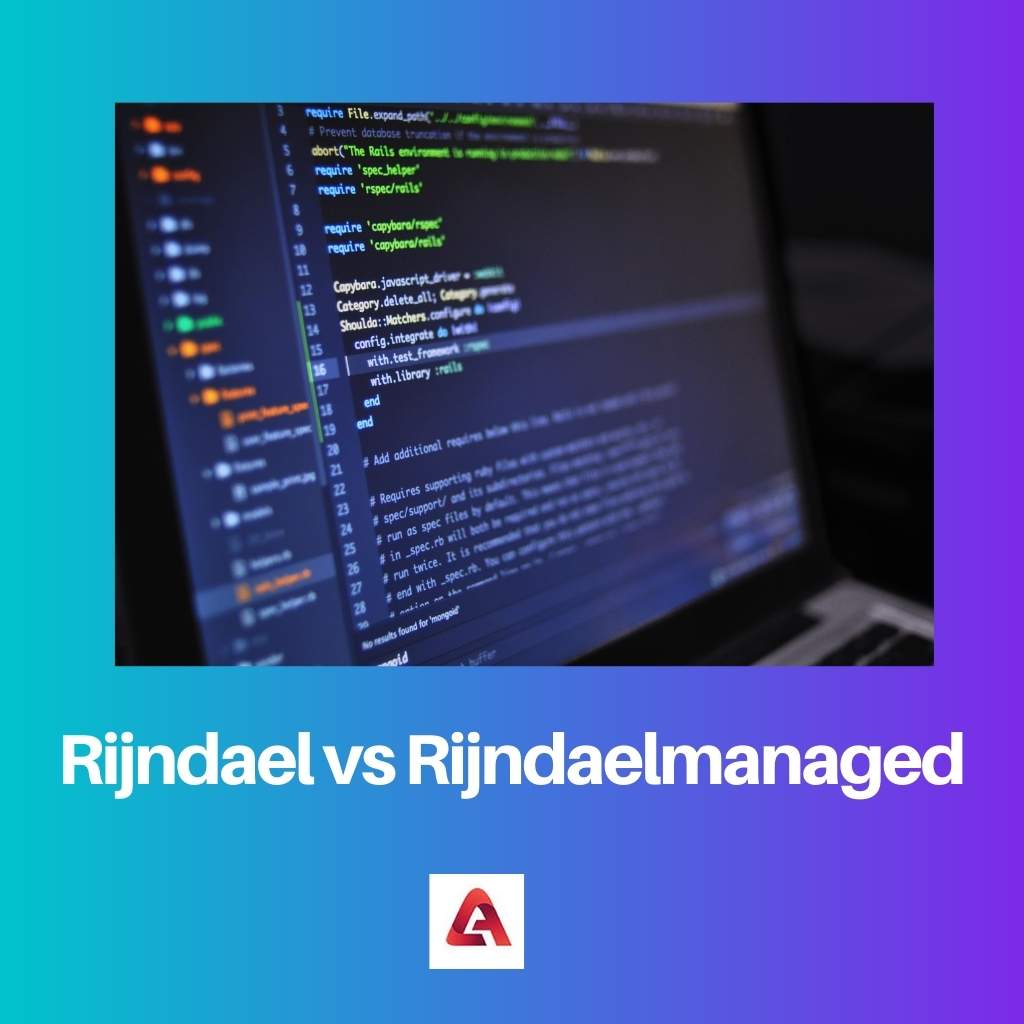Cryptology bisects into cryptography and cryptanalysis. Further, cryptography assorts a symmetrical algorithm and asymmetrical algorithm and protocols.
Cryptography is the introduction of encryption on the sender side, followed by decryption on the receiver side. This prevents access by an opponent. Rijndael and rijndaelmanaged are such algorithm. It was officially accepted in 2000.
Key Takeaways
- Rijndael is a symmetric key encryption algorithm selected as the US government’s Advanced Encryption Standard (AES).
- RijndaelManaged is a .NET class that provides a managed implementation of the Rijndael algorithm.
- Both serve the same purpose of providing encryption, but RijndaelManaged offers a more accessible interface for .NET developers.
Rijndael vs Rijndaelmanaged
Rijndael is a block cypher algorithm used for secure communication and data protection. It is a base class that is chosen as the Advanced Encryption Standard (AES). Rijndael managed is the derived, non-inheritable class of Rijndael. It comes under the public sealed category, indicating that the class cannot be extended further.

Rijndael is an encoding algorithm. Two Belgian scholars, namely Joan Daemen and Vincent Rijmen, introduced the world to an advanced encryption algorithm. In 1997, they initiated the formation of Rijndael.
By the name, we can tell Rijndael is a blend of Daemen and Rijmen. NIST, or the National Institute of Standard Technology, established Rijndael as AES’s candidate.
Rijndaelmanaged is the extended class of Rijndael. It utterly inherits the code of the base class (here Rijndael) apart from the initialization and destruction. We can not inherit Rijndaelmanaged as it is a sealed class.
The purpose of sealing Rijndaelmanaged is to prevent it from further being extended by the programmers.
Comparison Table
| Parameters of comparison | Rijndael | Rijndaelmanaged |
|---|---|---|
| Class | Base class | Derived class |
| Property | Inheritable | Non – inheritable |
| Category | Public abstract class | Public Sealed class |
| Instantiation | Automatically instantiated | It is not automatically instantiated |
| Dependency | It need not contact the derived class | It may contact the base class while initiating |
What is Rijndael?
With the collapse of DES, the US government was in desperate need of an advanced encryption algorithm. NIST initiated an internationally open competition in 1997.
Fifteen candidates came up with 15 different types of algorithms. Among them, five of them succeeded in the next round. Rijndael earned the stage in 2000.
Rijndael was designed efficiently by Vincent Rijmen and Joan Daemen. Rijndael is a block cipher. A block cypher is nothing but the encryption of plain text into ciphertext using a cypher key and vice versa. It is composed of boolean permutations that operate on bit vectors.
The block length and key length vary in Rijndael to any multiple of 32 bits. The minimum is 128 bits, and the maximum is 256 bits. The number of rounds is proportional to the key length.
10 rounds for 128 bits, 12 rounds for 192, 14 for 256. The security tightens with an increase in rounds. Each round consists of 4 sequences.
SubBytes step, followed by the ShiftRows step, followed by the MixColumns step and finally, the Key Addition step. While designing Rijndael, three criteria were considered, they are as follows
- Prevention from all the attacks,
- Design intelligibility
- Code conciseness and speed on the broad- spectrum.
What is Rijndaelmanaged?
Rijndaelmanaged is the derived class of Rijndael. It inherits the implementation of Rijndael. Like Rijndael, it is also a block cipher. The plain text is processed in blocks. It is a cryptography algorithm.
Rijndaelmanaged and managed private key cryptography. It utilizes one private key to encrypt the plain text into ciphertext and decrypt the ciphertext into plain text.
Application of Rijndaelmanaged
.NET
.NET core
.NET framework
.NET standard
Xamarin.Android
Xamarin.iOS
Xamarin.Mac
What it implies is that Rijndaelmanaged is a theoretical execution of Rijndael. We can not instantiate it. We can create an implementation of the base class that embodies a particular code and name it accordingly.
This is because we can implement from the base class and then exchange the layout of the derived class. The block length and the key length resemble that of the Rijndael.
A derived class like Rijmdaelmanaged is referred to as non-inheritable in contrast to its base class. Rijndaelmanaged belongs to the ‘public sealed’ category.
The seal implies that this class of algorithm cannot be further inherited or extended, unlike the base abstract class. The namespace used for Rijndaelmanaged is similar to that of Rijndael.
They fall under the Namespace ‘system.security.cryptography’.
Main Differences Between Rijndael and Rijndaelmanaged
- Rijndael is the base class, while Rijndaelmanaged is the derived class.
- Rijndael can instantiate on its own, while the latter is incapable of doing so.
- Rijndael falls under the category of ‘public abstract class’ whereas Rijndaelmanaged falls under ‘public sealed class’.
- The former is inheritable, unlike the latter, which can not be inheritable.
- The former, being the mother of the latter, need not depend on it, whereas the Rijndaelmanaged might need to contact the base class during instantiation.
The post is too technical, it’s hard to understand for a non-technical person.
The Rijndael algorithm seems to be an essential encryption tool.
I’m still confused about the differences, it needs a more straightforward approach.
It is indeed interesting content.
The article can be enhanced by providing more examples.
The article provides a comprehensive comparison between Rijndael and Rijndaelmanaged.
Sometimes sarcasm can be misinterpreted, I didn’t see it as amusing.
The article is very well-written and informative! I am sure I will learn a lot from it!
I’m not convinced, the author’s arguments need to be re-evaluated.
The author provides compelling arguments about the differences between Rijndael and Rijndaelmanaged.
The sarcasm in the post is outstanding, quite amusing.
Yes, it is educational.
Absolutely, it’s fascinating.